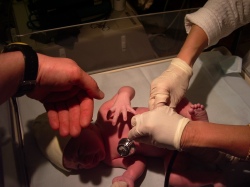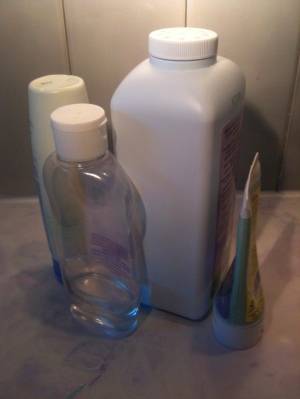 The other night one of my hypnobirthing couples asked me about the breast crawl. They thought that when their daughter is born, they would simply put baby to breast immediately, and that that would help her start breastfeeding faster, and therefore helping the placenta to come out faster. However they were wondering if there were any advantages to the breast crawl.
The other night one of my hypnobirthing couples asked me about the breast crawl. They thought that when their daughter is born, they would simply put baby to breast immediately, and that that would help her start breastfeeding faster, and therefore helping the placenta to come out faster. However they were wondering if there were any advantages to the breast crawl.
I figured that there are probably more of you out there, curious about what is the breast crawl, and why it is important.
The breast crawl is when a newborn baby is placed directly on the mom’s tummy and allowed to crawl on their own up to the breast and then latch on. It’s amazing to see.
That first hour after a baby is born is a really special time. Hormones from mom and from the placenta prepare the baby to meet the parents for the first time. They are wide eyed, alert and quiet; a state of consciousness in babies often referred to as Quiet Conscious. This is an ideal state for learning. The baby is taking it all in; hearing and remembering mom’s voice and dad’s voice too if dad has been present and interactive during the pregnancy. It’s a special period of settling in together.
Usually about 20 minutes after birth, babies have an instinct to head north and discover what’s there. However, the baby won’t feed if it isn’t ready or too tired or too groggy from drugs that mom has taken during labour. Narcotic medication either injected or used as agents in epidurals given to the mother during labor can transfer via the placenta to the infant and cause difficulty for the infant to latch on. This is the reason why many doctors will shy away from morphine or Demerol close to baby’s birth. They are more likely to use nitrous oxide, better known as laughing gas, which does not impact the infant in anyway after birth.
Current research is indicating that allowing the baby to initiate the crawl to the breast and latching on by themselves is an important developmental activity for baby. There is a set of behaviours starting from baby being placed on tummy to getting the nipple in their mouth which are all important for your baby. Each behaviour leads to the next. It allows the baby to be ready to take in the nipple when the sequence is allowed to play out.
In addition, there is a wealth of benefits for both mom and baby. Baby’s benefit by the warmth and comfort of being next to their mothers. They cry less and the body temperature is more safely regulated by the mother’s body. In addition, their metabolic rate is healthier and the quality of their latch better. For moms, there is the advantage of breastfeeding starting at a good time to help release the placenta. Placentas generally release between 20 and 60 minutes after baby’s birth. Finally the best benefit of all, bonding! This skin-to-skin, no rushing, calm initiation into breastfeeding deepens their bond.
There is a wealth of information of this topic at the website www.breastcrawl.org.; including a review of all the scientific research that has been done on this topic.
The same process of letting the baby manoeuvre its way to the breast is often referred to as baby led latching. This form of breastfeeding initiation allows for the baby instincts to kick in and helps to make the latching on process easier for both mom and baby.
Canadian breastfeeding expert, Teresa Pitman, wrote a great article on this topic, entitled Baby-Led Latch; how to awaken your baby’s breastfeed instincts. I highly recommend reading it before your baby is born. The excerpt is below.
What if babies were born knowing how to breastfeed? While that’s a new idea to most of us, it does make sense. Other newborn mammals know how to find and attach to their mother’s nipples, following inborn instincts in response to physical cues they receive from contact with the mother’s body.
Paediatrician Christina Smillie has found that human babies do, in fact, have quite remarkable abilities when it comes to breastfeeding.
“Baby’s instincts to look for and latch on to the breast involve a sequence of behaviours, where one behaviour leads to the next.”
She says that sometimes our attempts to help babies latch can actually interfere, by jumping the queue as it were. “When we start with the baby’s mouth at the nipple, we are skipping a lot of the early part of the sequence, which sets the stage and helps the baby organize his behaviour,” she explains. Of course, many babies do latch when put to the breast, and once a baby has latched several times, there is no need to follow the whole sequence. But for many babies who are learning to latch, Smillie says, “it is helpful to engage the full sequence.” CONTINUE READING
I also found this article about the 7 Natural Laws of Breastfeeding. It’s got really good information and again focuses on how to support the natural nursing instincts of baby and mom.
THE “NATURAL LAWS” OF BREASTFEEDING
Nancy Mohrbacher, IBCLC and Kathleen Kendall-Tackett, Ph.D., IBCLC
Today, most new mothers breastfeed their babies. But women often find breastfeeding more challenging than they expected. Mothers may experience sore nipples, engorgement, or low milk supply. Because of these challenges, many mothers quit breastfeeding in the first few days or weeks.
In 2003, a little more than 70% of American mothers began breastfeeding. But by three months, only 50% were breastfeeding and by six months this number dropped to 36%. Why do women give up on breastfeeding despite recommendations from the American Academy of Pediatrics to breastfeed for at least one year? Often times, it is because women don’t know how to work with their inborn abilities; what we’ve called the “natural laws” of breastfeeding. Based on the latest research, the natural laws can help you sort through conflicting breastfeeding advice and meet your breastfeeding goals.
Law #1: Babies are hardwired to breastfeed
Mothers often think breastfeeding is something they do to their babies. Actually, breastfeeding works best when babies and mothers are active partners. At birth babies have reflexes that cause them to instinctively push themselves up to the breast and latch on without any help at all. Just like all newborn mammals, our babies are born with the skills they need to feed. And the more their inborn hardwiring is understood and used, the more smoothly breastfeeding tends to go.
Law #2: Mother’s body is baby’s natural habitat
Mothers often wonder why newborns get so upset when they are set down. What moms don’t realize is that babies instinctually react this way. When newborn mammals are left alone, their survival instinct kicks in and they react in a way to bring mom back. Human babies have a similar response; when left alone they instinctually “know” that they must be re-united with their mothers. So they cry and protest. Their little bodies release stress hormones, which shuts down digestion and growth. In contrast, when they are with their mothers, they relax, allowing their bodies to grow. Touching and holding promotes healthy relationships and normal growth. When babies are not touched or held, they have physical and emotional problems, often for the rest of their lives.
Law #3: Better feel and flow happen in the comfort zone
Many mothers believe that painful cracked and bleeding nipples are a normal part of breastfeeding. Thank goodness this is not true! Nipple trauma often means that the baby needs to take the breast deeper into his mouth. When the baby is latched on well and the nipple is in the baby’s “comfort zone” (near where the roof of the mouth turns from hard to soft) breastfeeding should not hurt. When a mother is in pain, most likely all she needs are some minor adjustments to make breastfeeding comfortable (see www.BreastfeedingMadeSimple.com for more).
Law #4: More breastfeeding at first means more milk later
In the first few days after birth, a mother’s body is fully capable of providing everything her baby needs. Her first milk—colostrum—is available in just the right amounts. By breastfeeding long and often in the first weeks, a baby sets her mother’s milk supply for now and for later. Giving formula during this time decreases a mother’s milk supply and puts a baby at risk for later health problems.
Law #5: Every breastfeeding couple has its own rhythm
Mothers often wonder whether it’s best to feed their babies on demand or on a schedule. One factor they rarely mention, though, is the size of their babies’ stomachs. At first, a baby’s stomach is as small as a marble. This means that babies need to feed often and it is unreasonable to expect them to follow a schedule in the early days. When babies grow and their stomachs can hold more milk, they will often have more regular feeding patterns. When babies’ feeding is rigidly scheduled, especially in the early weeks, they become stressed and they may stop gaining weight.
Law #6: More milk out equals more milk made
With the latest research, we have a clearer picture of what affects milk supply, and it’s not fluid intake, diet, or rest. One vital factor is the number of times per day that you drain your breasts. The more often and fully you drain your breasts, the more milk you produce. Another factor affecting milk supply is how much milk a mother’s breasts can comfortably hold, because drained breasts make milk faster and full breasts make milk slowly. Anyone who tells you that you need to let your breasts “fill up” before feeding has got it all wrong!
Law #7: Children wean naturally
When it is time to wean, many mothers are told to just stop breastfeeding, bind their breasts, and wait until the milk (and pain) is gone. But this is the most difficult weaning possible. What most mothers don’t know is that weaning doesn’t have to be traumatic. All children will eventually outgrow breastfeeding, even if you do nothing.
In summary, the seven laws of breastfeeding can help make breastfeeding the simple and joyful experience it was meant to be. To learn more, visit our Web site: www.BreastfeeedingMadeSimple.com.
Nancy Mohrbacher, IBCLC and Kathleen Kendall-Tackett, Ph.D., IBCLC are authors of Breastfeeding Made Simple: 7 Natural Laws for Nursing Mothers (October 2005, New Harbinger Publications). Article to appear in Cleveland Family, Fall 2005.





14 thoughts on “The Breast Crawl”
Thank you so much for this article! I was just wondering if there were advantages to doing the breast crawl over simply putting the baby to the breast. Now I know that there are, and I know what they are! It sounds like the breast crawl will definitely be the right option for me. 🙂
The video has been removed by user
Thanks Chloe. I found two more. I hope you found the information helpful.
Does the breast crawl “happen” after the cord has been cut? I’m curious of the steps so that I know how to “plan.” Thanks!!
Yup. The delayed cord clamping only takes between 2-5 minutes. Babies generally start the breast crawl a bit later. First they just want to look at you. HONEST. And you just want to look at them. 🙂 The breast crawl generally starts about 10 minutes after birth and it can take them quite a long time (10-30 minutes) to make it up to your boob, so be patient. The reward is so worthwhile. Don’t worry to much about trying to micro manage it, rather let your feelings and instincts guide you. After the cord is cut, just enjoy your baby laying on your belly or chest and then let nature take it course.
It would be wonderfully if you came back here and let us know how it goes.
Blessings,
Marie
what about water births? how would you do the breast crawl then? just wait til you get out and then let that happen? or is there a way to allow this while still in the birth pool?
Hi Michelle,
Yes you can still do this with a water birth. Most women will hang out in the water for a while (5 to 10 minutes) after their baby is born and then get out and find somewhere comfy (bed or couch) to cuddle together on. You could do the breast crawl in the water, but depending on the size of the birthing tub and the level of the water, you might find it a bit awkward. Plus it will mean you’ll be in the water for a lot longer (20-30 minutes post birth at least). So most women will simply put baby on their chest, skin to skin, after they get out of the water and then let the breast crawl happen. My advice to you if you are planning a water birth, is to simply let it unfold. If you are comfy in the water after birth, let nursing begin there. If you don’t feel comfy in the water anymore or just can’t seem to get into a good position (semi-reclined is easiest) for the breast crawl, then get out and do it on “dry land”. Either is just fine!
Interesting. My first thought after watching these was: I wonder if this is a possible avenue for SIDS research. Maybe we’re missing some natural step or milestone and that’s why some babies end up rebreathing? I know breast feeding helps– and that mastering suck-swallow-breathe is an accomplishment in and of itself, but the breast crawl seems kind of HUGE. Can’t wait to see that research study.
Truly beautiful. I wish I had been more patient instead of feeling pressured to get baby to breast…Next time!